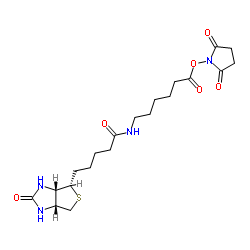生物素化-epsilon-氨基己酸-N-羟基丁二酰亚胺活化酯

生物素化-epsilon-氨基己酸-N-羟基丁二酰亚胺活化酯结构式

|
常用名 | 生物素化-epsilon-氨基己酸-N-羟基丁二酰亚胺活化酯 | 英文名 | Biotin-C5-NHS Ester |
|---|---|---|---|---|
| CAS号 | 72040-63-2 | 分子量 | 454.540 | |
| 密度 | 1.4±0.1 g/cm3 | 沸点 | N/A | |
| 分子式 | C20H30N4O6S | 熔点 | 169-171 °C | |
| MSDS | 美版 | 闪点 | N/A |
|
Avidin binding of carboxyl-substituted biotin and analogues.
Biochemistry 21 , 978-984, (1982)
|
|
|
Ligation of major histocompatability complex (MHC) class I molecules on human T cells induces cell death through PI-3 kinase-induced c-Jun NH2-terminal kinase activity: a novel apoptotic pathway distinct from Fas-induced apoptosis.
J. Cell Biol. 139 , 1523-1531, (1997) Ligation of major histocompatability complex class I (MHC-I) molecules expressed on T cells leads to both growth arrest and apoptosis. The aim of the current study was to investigate the intracellular signal pathways that mediate these effects. MHC-I ligation... |
|
|
ATM-dependent phosphorylation of Mdm2 on serine 395: role in p53 activation by DNA damage.
Genes Dev. 15 , 1067-1077, (2001) The p53 tumor suppressor protein, a key regulator of cellular responses to genotoxic stress, is stabilized and activated after DNA damage. The rapid activation of p53 by ionizing radiation and radiomimetic agents is largely dependent on the ATM kinase. p53 is... |
|
|
Rapid and sensitive colorimetric method for visualizing biotin-labeled DNA probes hybridized to DNA or RNA immobilized on nitrocellulose: Bio-blots.
Proc. Natl. Acad. Sci. U. S. A. 80 , 4045-4049, (1983) Biotin-labelled DNA probes, prepared by nick-translation in the presence of biotinylated analogs of TTP, are hybridized to DNA or RNA immobilized on nitrocellulose filters. After removal of residual probe, the filters are incubated for 2--5 min with a preform... |
|
|
Enhancement of immune cellular agglutination by use of an avidin-biotin system.
Clin. Chem. 25 , 1572, (1979) Classically, one can increase the titer of an agglutinating or first antibody with an antiglobulin or second antibody. We have used an avidin-biotin system in place of antiglobulin to similarly extend the agglutination by an initial anticellular antibody. Ery... |
|
|
Proteinase K-sensitive disease-associated ovine prion protein revealed by conformation-dependent immunoassay.
Biochem. J. 401 , 475-483, (2007) PrPSc [abnormal disease-specific conformation of PrP (prion-related protein)] accumulates in prion-affected individuals in the form of amorphous aggregates. Limited proteolysis of PrPSc results in a protease-resistant core of PrPSc of molecular mass of 27-30 ... |
|
|
In-situ monitoring of protein labeling reactions by matrix-assisted laser desorption/ionization mass spectrometry.
Fresenius J. Anal. Chem. 366(1) , 3-9, (2000) Taking the labeling reaction of horse heart cytochrome c or ubiquitin with biotinamidocaproate N-hydroxysucchinimide ester (biotin-NHS) as test cases, this report demonstrates the usefulness of matrix-assisted laser desorption/ionization (MALDI) mass spectrom... |
|
|
Synthesis and biodistribution of 211At-labeled, biotinylated, and charge-modified poly-L-lysine: evaluation for use as an effector molecule in pretargeted intraperitoneal tumor therapy.
Bioconjug. Chem. 13(3) , 502-9, (2002) Poly-L-lysine (7, 21, and 204 kDa) has been evaluated as an effector carrier for use in pretargeted intraperitoneal tumor therapy. For the synthesis, the epsilon-amino groups on the poly-L-lysine were modified in three steps utilizing conjugate biotinylation ... |
|
|
Novel chemical method for the preparation of nucleic acids for nonisotopic hybridization.
J. Clin. Microbiol. 23(2) , 311-7, (1986) A novel chemical method was used to prepare biotin-labeled nucleic acids for nonisotopic hybridization. The method involves the transamination of unpaired cytosine residues in polynucleotides with sodium bisulfite and ethylenediamine. Primary amino groups on ... |
|
|
Microfluidic chip with electrochemiluminescence detection using 2-(2-aminoethyl)-1-methylpyrrolidine labeling.
J. Chromatogr. A. 1091(1-2) , 158-62, (2005) A tertiary amine derivative, 2-(2-aminoethyl)-1-methylpyrrolidine (AEMP) was successfully developed as electrochemiluminescence (ECL) probe within microfluidic chip using ECL detection in this paper. The system was characterized by the interaction between bio... |